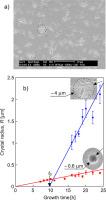Assessing the early stages of crystal nucleation and growth in a deeply supercooled glass-forming liquid
IF 9.3
1区 材料科学
Q1 MATERIALS SCIENCE, MULTIDISCIPLINARY
引用次数: 0
Abstract
For treatments conducted below the glass transition temperature (Tg), the extrapolated size–time dependence of micron-sized crystals often suggests a growth “induction period”, as the data fail to extrapolate back to the origin (time = zero). We refute this notion by presenting, for the first time, experimental evidence of the early stages of barium disilicate (BaSi2O3) crystal growth in an isochemical glass. Through electron microscopy measurements of nanometric crystal sizes, we demonstrate that the growth velocity—and, consequently, the derived effective diffusion coefficients that govern both nucleation and growth—are valid from the earliest stages of the transformation. When combined with (a fitted) interfacial energy, this growth-based diffusion coefficient enables an accurate analysis of crystal nucleation data below Tg within the framework of Classical Nucleation Theory, provided that a structural order parameter is introduced to account for structural relaxation. This refined approach (using diffusion coefficients derived from the early growth velocities) successfully describes the crystal nucleation dynamics in a BaSi2O3 glass, addressing limitations of previous studies that inferred the diffusion coefficient based on advanced growth stages.

在深度过冷玻璃成形液中评估晶体成核和生长的早期阶段
对于低于玻璃化转变温度(Tg)的处理,外推的微米尺寸晶体的尺寸-时间依赖性通常表明存在生长“诱导期”,因为数据无法外推回原点(时间= 0)。我们首次提出了二硅酸钡(BaSi2O3)晶体在等化学玻璃中生长的早期阶段的实验证据,反驳了这一观点。通过纳米晶体尺寸的电子显微镜测量,我们证明了生长速度——以及由此推导出的控制成核和生长的有效扩散系数——在转变的早期阶段是有效的。当与(拟合的)界面能相结合时,只要引入结构顺序参数来解释结构弛豫,这种基于生长的扩散系数就可以在经典成核理论的框架内精确分析Tg以下的晶体成核数据。这种改进的方法(使用从早期生长速度导出的扩散系数)成功地描述了BaSi2O3玻璃中的晶体成核动力学,解决了先前研究基于晚期生长阶段推断扩散系数的局限性。
本文章由计算机程序翻译,如有差异,请以英文原文为准。
求助全文
约1分钟内获得全文
求助全文
来源期刊

Acta Materialia
工程技术-材料科学:综合
CiteScore
16.10
自引率
8.50%
发文量
801
审稿时长
53 days
期刊介绍:
Acta Materialia serves as a platform for publishing full-length, original papers and commissioned overviews that contribute to a profound understanding of the correlation between the processing, structure, and properties of inorganic materials. The journal seeks papers with high impact potential or those that significantly propel the field forward. The scope includes the atomic and molecular arrangements, chemical and electronic structures, and microstructure of materials, focusing on their mechanical or functional behavior across all length scales, including nanostructures.
 求助内容:
求助内容: 应助结果提醒方式:
应助结果提醒方式:


